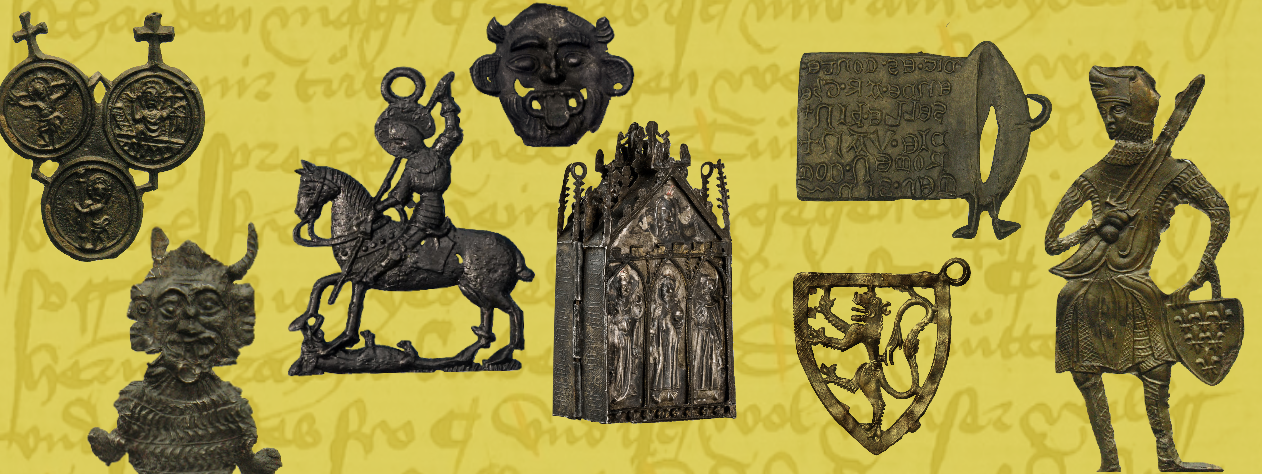““He had big bulging eyes, just like a hare.
He’d sewn a Vernicle on his cap.”
– A description of the Pardoner in Chaucer’s Canterbury Tales.
Tin Lead Alloy, Veronica Icon: countenance of Christ on a veil, surrounded by dots in round frame, Rome, 1000-1599, 310 x 400 mm. King’s Lynn, Lynn Museum, PB 49 (Kunera 07520). Photo courtesy of Shannon Phaneuf.
The vernicle was a popular badge which showed the Veronica: an image of Christ’s face on Saint Veronica’s veil. One delicate, fifteenth-century vernicle was found around a hundred years ago in the muddy River Great Ouse in Norfolk, far away from Rome where it was made and sold to traveling pilgrims. This vernicle was discovered by children, who had been hired by Thomas Pung in King’s Lynn to search the river for such finds.
St Veronica standing, holding the veil in front of her; a reversed copy after Marcantonio Engraving. Photo courtesy of the British Museum 1869,0410.13, AN37921001
Have you ever thought about why people traveled in the late Middle Ages? Besides trade and war, the most popular reason to go abroad was to undertake a pilgrimage. Just like travel today, pilgrimage, which promised spiritual rewards, was widespread among all social classes. Pilgrims would often buy small pewter and lead alloy badges at the holy sites they visited. These badges signified the completion of their journey and were a sign of devotion and commemoration.
The vernicle is a representation of the veil of Saint Veronica, a so-called contact relic (because it was believed to have been in contact with the living Christ) and symbol of a miracle. Legend held that the miracle happened when Saint Veronica used her veil to wipe the sweat and blood off Jesus’ face as he was walking to his crucifixion, leaving an imprint of his face permanently on the cloth. The shrine of the Veronica was one of Rome’s biggest pilgrim attractions in the Middle Ages. The first direct references to its existence are from the end of the twelfth century. At that time, it was hidden behind a curtain, away from the public. Pope Innocent III (b. 1161-d. 1216) brought it closer to the public by parading it through the streets on Fridays and feast days. Allowing pilgrims this access helped make Rome an ever more popular pilgrim destination. By the early seventeenth century, the Veil of Veronica had disappeared from public view. If it is still housed in Rome, it has very likely disintegrated. Textiles usually do not last more than two thousand years, although there are exceptions due to preservation conditions such as the Tarkhan Dress which is over 5,000 years old. Due to its frequent exposure in the Middle Ages most scholars believe that the Veronica is no longer extant.
Written by Sarah Johnston and Mackenzie Pritchard.
Works Cited
Birch, D. Pilgrimage to Rome in the Middle Ages (Suffolk: Boydell Press, 1998).
Clark, John. Medieval finds from the River Thames: Accidental Loss, Rubbish or Ritual? Powerpoint presentation, 2017.
Hopper, Sarah. To Be a Pilgrim: The Medieval Pilgrimage Experience (London: Sutton Publishing Limited, 2002).
Rasmussen, Ann Marie. “Material Meanings: What a Medieval Badges Can Tell You about Translation in the Middle Ages.” In Un/Translatables: New Maps for German Literature edited by Catriona Macleod and Bethany Wiggin, 215–28 (Evanston, Illinois: Northwestern University Press, 2016).
Weitbrecht, Julia."The Vera Icon (or Veronica) in the Verse Legend Veronica II: Medialising Salvation in the Late Middle Ages,“ in Seminar: A Journal of Germanic Studies 52, no.2 (2016): pp. 173–92.


